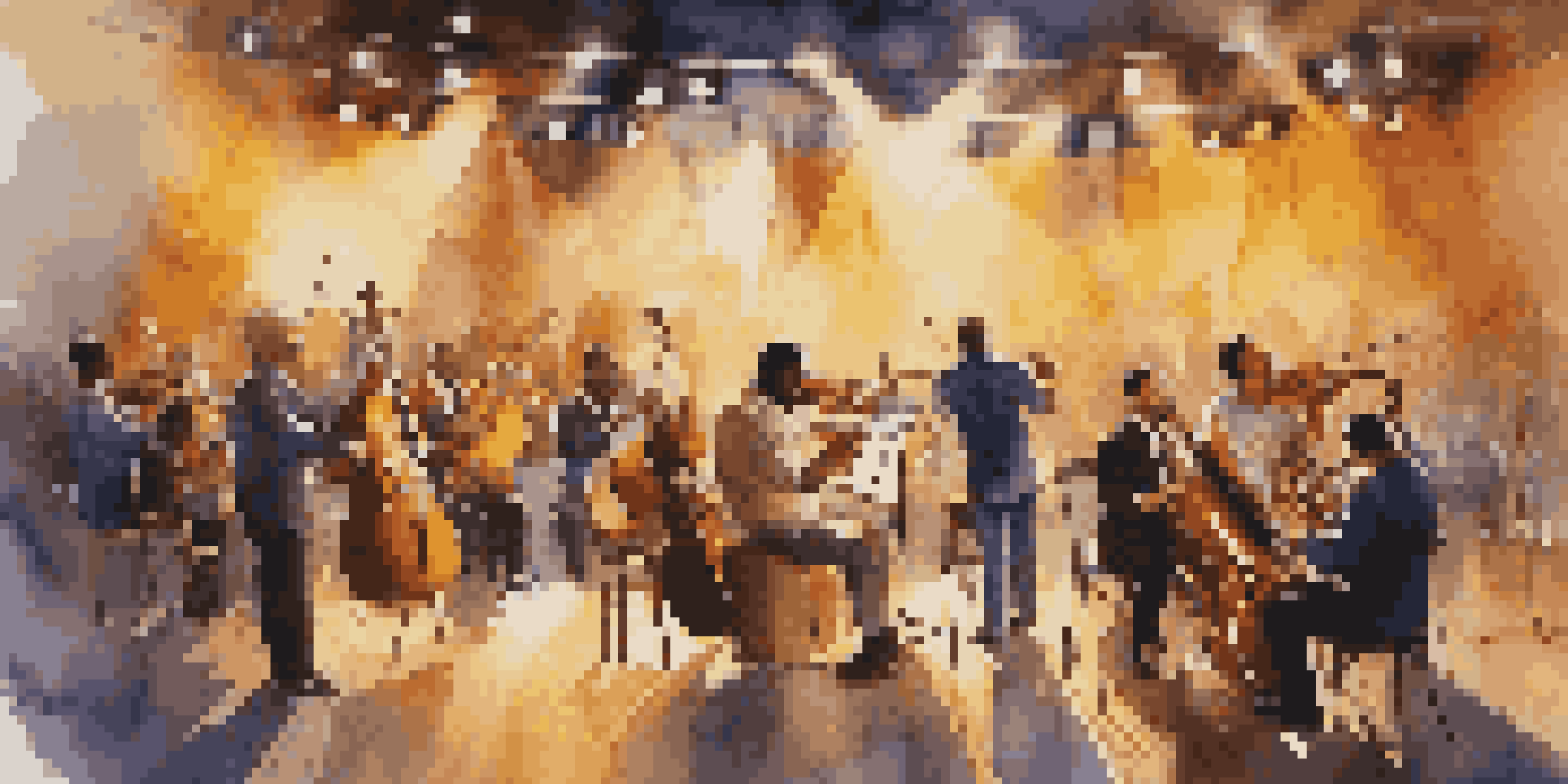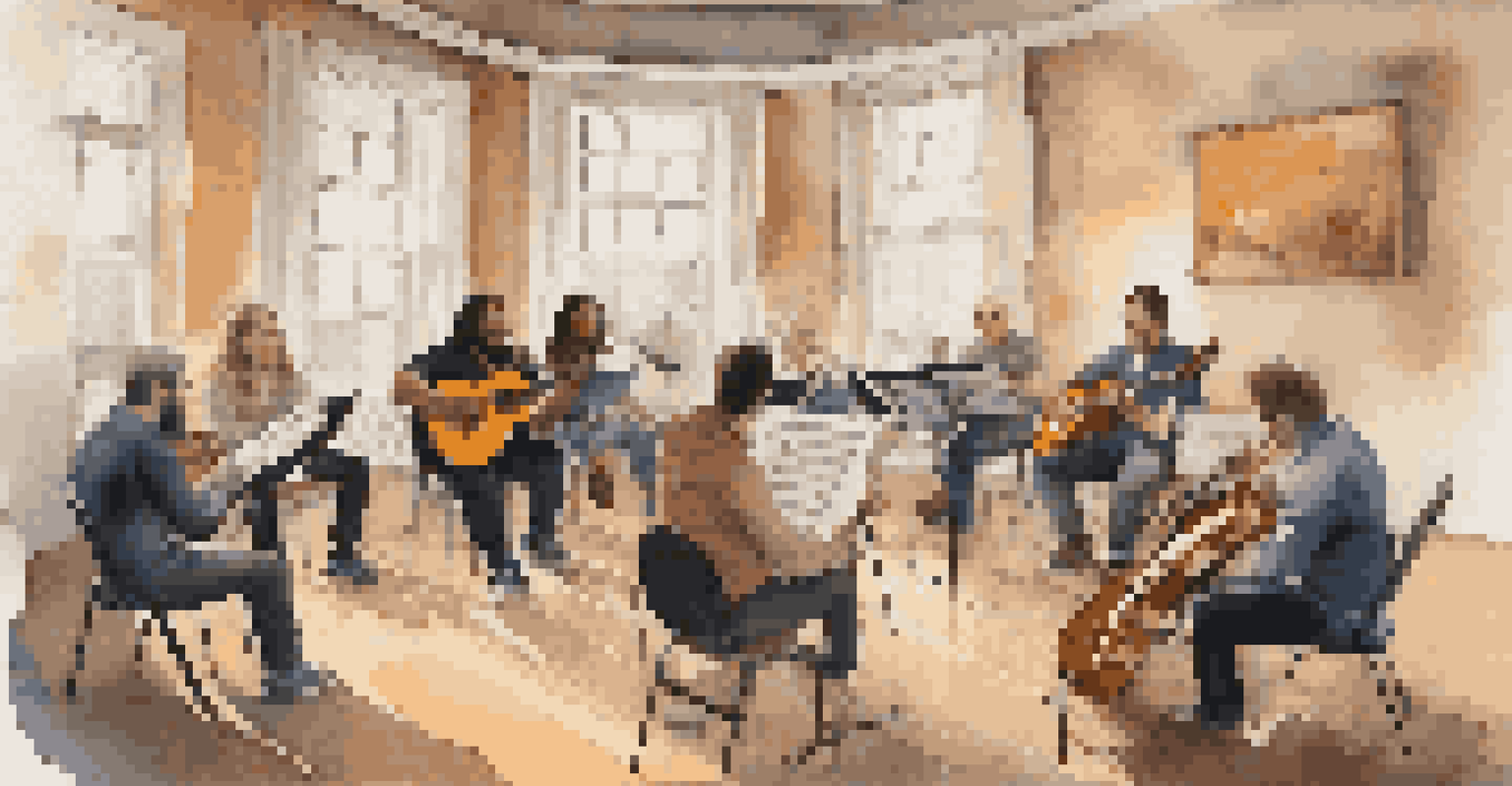Effective Communication Techniques for Ensemble Musicians

Understanding the Importance of Communication in Ensembles
Effective communication is the backbone of any successful musical ensemble. It ensures that all members are on the same page, allowing the music to flow seamlessly. When musicians communicate well, they can respond to each other’s cues, creating a more cohesive sound.
Music is the shorthand of emotion.
Think of an ensemble like a conversation; each musician adds their voice to the dialogue. Without clear communication, messages can get lost, leading to confusion and dissonance. By prioritizing communication, musicians can foster a supportive environment where everyone feels valued.
Moreover, strong communication skills can boost confidence among ensemble members. When musicians know they can trust each other to listen and respond, they’re more likely to take risks and express their creativity, ultimately enhancing the overall performance.
Non-Verbal Communication: The Power of Body Language
Non-verbal communication is a crucial aspect of ensemble performance. Musicians often rely on gestures, facial expressions, and eye contact to convey messages without saying a word. This form of communication can signal changes in tempo, dynamics, or mood, helping musicians stay in sync.

For example, a simple nod can indicate a cue to start playing, while a raised hand might signal a pause. By mastering these non-verbal cues, musicians can enhance their ensemble's cohesion. It’s like having a secret language that only the musicians understand.
Communication is Essential in Ensembles
Effective communication fosters a cohesive sound and enhances trust among musicians.
Practicing body language in rehearsals allows members to become comfortable with these signals. The more familiar they are with one another's gestures, the more fluid their performances will be, allowing for a richer and more expressive musical outcome.
Active Listening: The Key to Successful Collaboration
Active listening is essential for effective ensemble communication. It goes beyond just hearing the notes; it involves understanding the musical intentions of fellow musicians. By truly listening, musicians can respond thoughtfully and adapt their playing to complement each other.
The most important thing in communication is hearing what isn't said.
Consider how a basketball team functions. Players must listen to each other on the court to anticipate moves and create plays. Similarly, ensemble musicians must engage with each other’s sound to create harmonious music. This kind of interaction fosters trust and collaboration.
To practice active listening, musicians can focus on their peers during rehearsals. This means not only hearing the music but also feeling the energy and emotion behind it. As members become more attuned to each other, the ensemble’s performances will reflect a deeper connection.
Establishing Clear Roles and Responsibilities
In an ensemble, clarity about roles and responsibilities can significantly improve communication. Each musician brings unique strengths, and understanding these roles helps the group function effectively. When everyone knows their part, it reduces confusion and enhances accountability.
For instance, a conductor's role is to guide the ensemble, while each musician should focus on their individual contributions. This is similar to a well-oiled machine; each part must work in harmony for the whole to operate smoothly. Clear delineation of roles allows for better coordination.
Non-Verbal Cues Enhance Performance
Body language and gestures play a crucial role in conveying messages and maintaining synchronization.
Regular discussions about individual and collective responsibilities can help reinforce this clarity. Ensemble members can share their expectations and work towards a common goal, ensuring that everyone is aligned. This proactive approach not only improves communication but also strengthens the ensemble's bond.
Creating a Safe Space for Open Feedback
Feedback is a vital component of growth in any ensemble, but it must happen in a safe space. Musicians should feel comfortable sharing their thoughts and suggestions without fear of judgment. This openness encourages honest dialogue that can lead to improved performances.
Imagine a classroom where students can freely express their ideas. Similarly, in an ensemble, fostering an environment where feedback is welcomed promotes trust. When musicians know that their opinions are valued, they’re more likely to contribute positively to discussions.
Establishing regular feedback sessions can help normalize this practice. Musicians can discuss what worked well and what could be improved, creating a culture of continuous learning. This ongoing dialogue ultimately elevates the ensemble’s performance quality.
Utilizing Technology for Enhanced Communication
In today’s digital age, technology can significantly enhance communication among ensemble musicians. Tools like group messaging apps, video conferencing, and collaborative platforms can streamline communication, especially for remote or hybrid ensembles. These technologies make it easier to share ideas and make decisions.
For example, a shared online calendar can help schedule rehearsals and keep everyone informed. Similarly, recording sessions can be reviewed to analyze performance and discuss improvements. Technology acts as a bridge, connecting musicians and facilitating discussions even when they’re not physically together.
Feedback Promotes Growth and Trust
Creating a safe space for open feedback encourages honest dialogue and continuous improvement within the ensemble.
However, it’s essential to use technology mindfully. Avoid overwhelming members with too many platforms, as this can lead to confusion. Instead, choose a few effective tools that everyone can comfortably use, promoting efficient communication without the clutter.
Embracing Diversity and Inclusion in Communication
Diversity within an ensemble can greatly enrich the communication experience. Musicians come from various backgrounds, each bringing unique perspectives and ideas. Embracing this diversity fosters creativity and innovation, enhancing the ensemble's overall sound.
However, it's vital to ensure that all voices are heard. Creating an inclusive environment encourages members to share their thoughts and contributions freely. This is akin to a potluck dinner, where everyone brings a dish that reflects their culture, creating a feast of flavors.

To promote inclusivity, ensembles can establish norms that encourage participation from all members. Encouraging everyone to share their ideas and experiences can lead to more dynamic discussions and creative solutions. Ultimately, diverse communication enriches the ensemble's artistry.